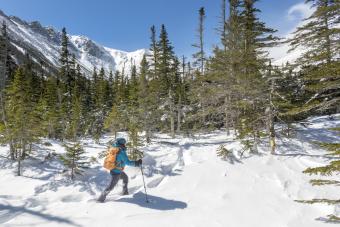
Hiking in the wintertime is an invigorating experience. The crisp, cold air fills your lungs, the snow crunches beneath your feet, and the world lies still under a blanket of white. One of the best places in the country to take this activity on is in New Hampshire. Nestled among the White Mountains, this region is an outdoorsman's playground, and there is no better space to hit up countless winter hikes.
Easy Winter Hikes in New Hampshire
The great thing about hiking is that anyone can get into the hobby. Beginners will want to start slow as they learn their body's limits and utilize easy but stunning trails to learn to art of hiking in the wintertime.
Lincoln Woods Trail
Not every New Hampshire hike involves mountains, and the Lincoln Woods Trail is a prime example of a beautiful, easy winter hiking experience that leaves the mountains to the wayside. It is one of the most popular trails in the White Mountain National Forest, and it is used by hikers, snowshoe enthusiasts, and cross-country skiers alike. The trek is often busy, even during the colder winter months. It spans just under 3 miles and stays relatively flat, with a slight incline of a few hundred feet over the course of the hike. A unique thing about this area is that it is often referred to as a wilderness gateway. It leads to one of the largest roadless areas in the eastern United States, the Pemigewasset Wilderness.
West Rattlesnake Mountain
Located in Holderness, West Rattlesnake Mountain and Mount Morgan trailhead give beginners unparalleled views of frozen lakes, bare trees, and rock outcrops. Hikers will need to trek some 2 miles to get to the summit, but the elevation changes are not great, and with some care for icy paths and a good pair of winter hiking boots, this feat is doable for most. There are several natural spaces to stop along the way so hikers can take in the surrounding views. While the summit will probably be slippery during the cold and snowy months, hikers who have visited this space say that the area is fairly flat, making it easy to revel in what you just accomplished.

Diana's Bath
This favorite New Hampshire hiking spot sits near North Conway and Bartlett. During the summer months, hikers splash about in the cool, pristine waters, and in the fall, the foliage that lines the trail is nothing short of spectacular. Wintertime is just as magical at Diana's Bath as the waterfalls freeze, creating a winter scene unparalleled. Because the trail is just over a mile in length, most everyone can manage the trek, with the major danger here being the slippery rocks that dot the terrain. A sturdy pair of hiking boots will help outdoors people safely navigate Diana's Bath.
Moderate Winter Hiking Trails in New Hampshire
For hikers who have mastered the flat, short, and easy trails located throughout scenic New Hampshire, these moderately challenging areas give hikers a little more elevation change, more distance to cover, and new and wondrous sights to feast their eyes on.
Webster-Jackson Trail
The Mount Jackson hike is an excellent way to spend a wintery, northeastern day. Hiking the Webster-Jackson trail will give hikers stunning views of Mount Washington and Crawford Notch once they reach the summit. This hike, which starts in Crawford Notch, takes about four to five hours and spans roughly 5.3 miles. The elevation changes are gradual, making it feasible for most hikers to reach the summit. The vast majority of the hike keeps hikers unexposed to the elements, sheltering them as they make their trek to the top.

Mount Pierce
Mount Piece is a stone's throw from Mount Jackson and the Webster-Jackson Trail. With two beginner trails so close to each other, these spaces are great choices for hikers who want to make a weekend of winter hikes in New Hampshire. This trail, like Mount Jackson, is a gradual elevation hike, easy on the knees and easy on the lungs. From the summit, hikers can take in the sights of the Southern Presidentials.

Garfield Trail
The Garfield Trail hike will lead winter wanderers up Mount Garfield. This hike is certainly more challenging than the Mount Pierce or Mount Jackson hikes, but that is largely because it is nearly doubled in length at a distance of ten miles. The trail gives hikers a steady incline up to the summit, leading them through manageable switchbacks that help to make this hike doable. While the trail does include some steeper sections as hikers near the finish, these elevation changes are not terribly trying, even for beginners or middle-of-the-road hikers. The views make the long hike worthwhile, with sights of the Twins to the east and sights of Franconia Ridge to the west.
Challenging Winter Hiking Trails in New Hampshire
Experienced hikers can take on more complex trails. New Hampshire has no shortage of challenging hiking trails for avid hikers to try their hand (and booted feet) at.
Cannon Mountain Loop Trail
Cannon Mountain is located in Franconia Notch State Park and is part of the Kinsman Range. Here hikers can really test their skills as the trail winds through nearly 4.5 miles of rugged terrain. An elevation increase of over 2,000 feet further tests hikers in their ability to march up mountains in blustery winter conditions. All things considered, this hike is a difficult one that experienced hikers only will want to consider.

The Great Gulf Trail
This challenging trail is located on Mount Washington's northern side. It spans almost eight miles in distance and forces hikers to hike and climb 5,000 feet in elevation. Hikers follow the paths up a giant bowl-like valley called Great Gulf. What makes this hiking experience a trial for even the most seasoned hikers and climbers is the final mile. Hikers must complete a 1700′ ascent up a one-mile avalanche slide to reach the summit. This abrupt climb into the skies can come with low visibility, slippery terrain, windy gusts, and any other number of winter element setbacks.
Huntington Ravine Trail
The Huntington Ravine Trail has been considered one of the most challenging winter hiking experiences that New Hampshire offers, if not the most challenging one! Located on the eastern face of Mount Washington, The Huntington Ravine Trail is a steep bowl-shaped valley called a glacial cirque. Hikers taking this trail will have to navigate rocky walls and exposed ledges. They also must utilize handholds and intricate footwork if they have any hope of completing the trek. While the trail starts pretty doable, at one mile in, hikers experience an elevation gain of 1650′ over only a distance of a mile. That is some seriously steep hiking!
While hikers can take this trail up, it is not advised that they descend it, and even savvy hikers should find an alternative route to come down the mountain. Those with heavy backpacks and little experience are also cautioned to choose another hiking destination. This area is prone to avalanche activity in the winter months, so anyone taking this trail on needs to know what the avalanche forecast is for this trail at all times.

Mahoosuc Trail
The Mahoosuc Trail is the head honcho and the big Kahuna when it comes to New Hampshire hiking. It is remote and wild, set back in the thick forest coverage of the Mahoosuc mountain range. The trail might not have the tricky and sudden elevation changes that some other challenging hikes have, but this 27.3-mile journey comes with its own mixed bag of hiking tricks. It will include an elevation gain of over 10,000 feet, although the gains are spread out more discreetly compared to other trails and their elevation spikes.
Hikers need to know how far they can make it in a single day before setting up camp. A long winter hiking excursion such as this one needs to be carefully mapped out, and provisions should be consciously packed to span several days if the entire mileage is to be conquered. Hikers on the trail can count on trudging through thick snow and sticky mud when the sun warms the earth. Bugs are a concern in the summer months, but long exposure to the elements and sudden changes in weather patterns during the winter months is this trail's greatest cause for concern.
Winter Hiking: Not the Same as Summer Hiking
Yes. Hiking is something that just about anyone can take up. That said, many hiking passes are not child's play, and they deserve careful considerations before hikers choose to take them on. Second, hiking in the wintertime is far more perilous than hiking in the summer months. Be aware of the winter woes that can arise when hiking in the colder season.
- Low temperatures and heat loss - When the digits plummet, and you are out in the elements, you must be prepared.
- Harder physical exertion - Walking through snow creates resistance, making it hard to take on longer treks.
- Snow and ice - A slip and fall on a long hike is never a good thing.
- Easier to get lost - Snow can cover markers and trails, making it easy for hikers to lose their way.
- Weather changes - In the winter, the weather patterns can change in the blink of an eye.
Before taking winter hiking on in New Hampshire or anywhere else, be sure that you are prepared on all levels. Have the correct winter hiking gear to help you be successful in your endeavors. Be sure to know your surroundings and choose trails that are within your hiking wheelhouse. Before heading into the wilderness, always let someone know where you are headed when you expect to return, and the route you plan to take in case of an emergency.
Final Words on Winter Hiking
Unless you've experienced it yourself, it's very hard to describe to others the feeling of bringing a foamy warm hot chocolate up to your chilled trembling lips, with hands so numb that you can hardly feel the cup through your gloves. The feeling of pure exhilaration and accomplishment, upon reaching the summit, is so great that the many hours spent struggling against the cold and the driving wind all becomes worthwhile. The wilderness of New Hampshire is a hiking paradise and is certainly a space all climbers, hikers, and outdoors people should put on their bucket list.







